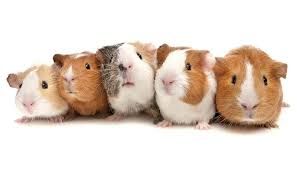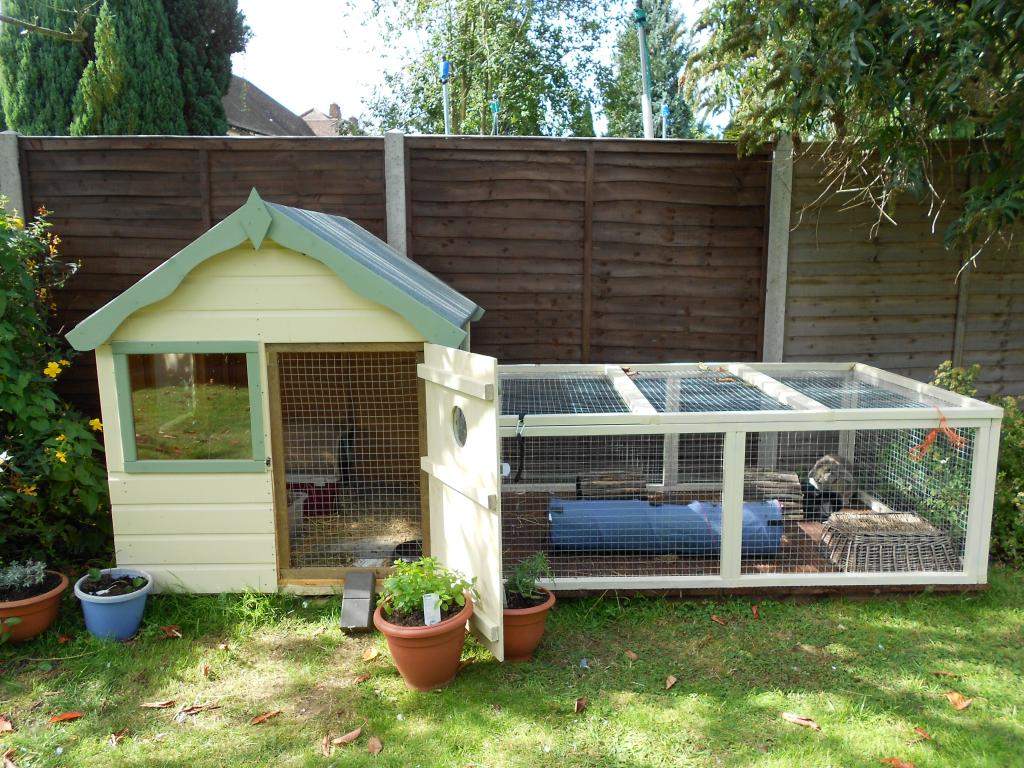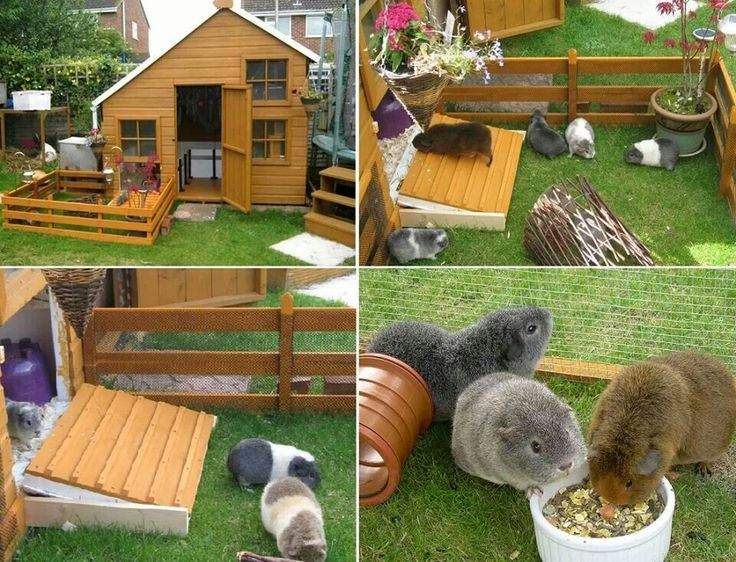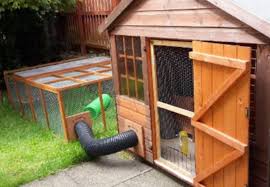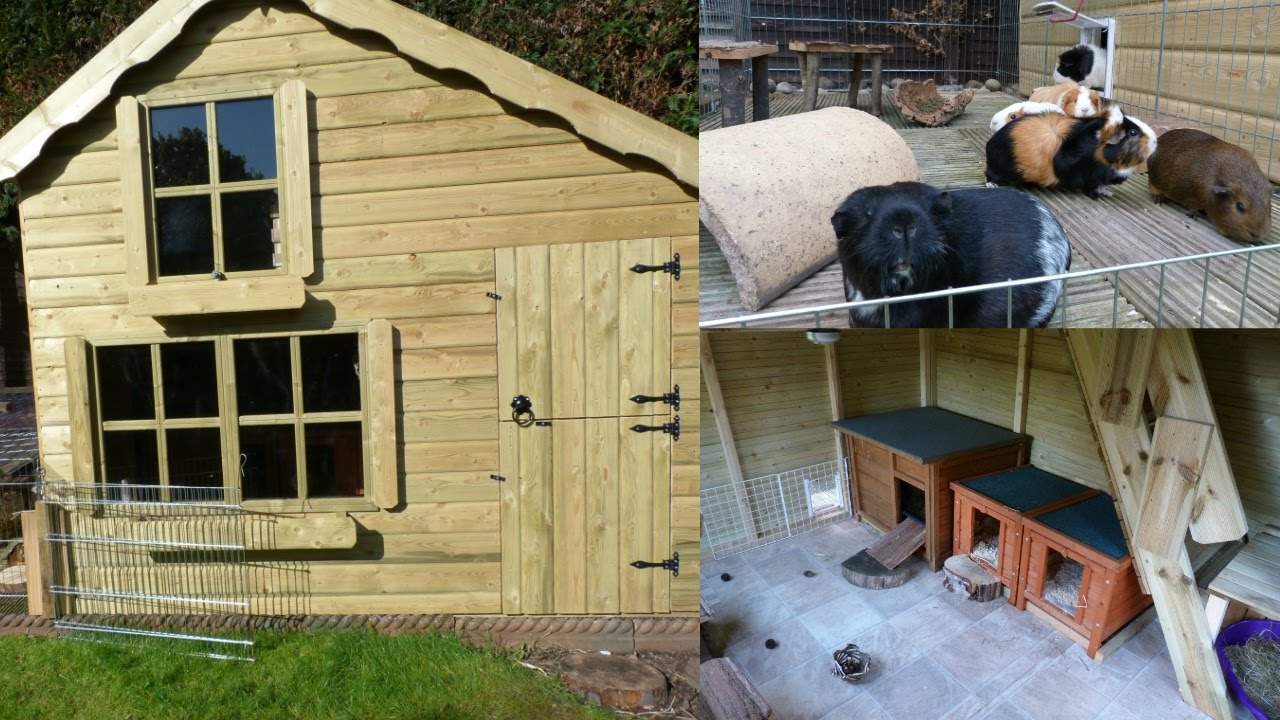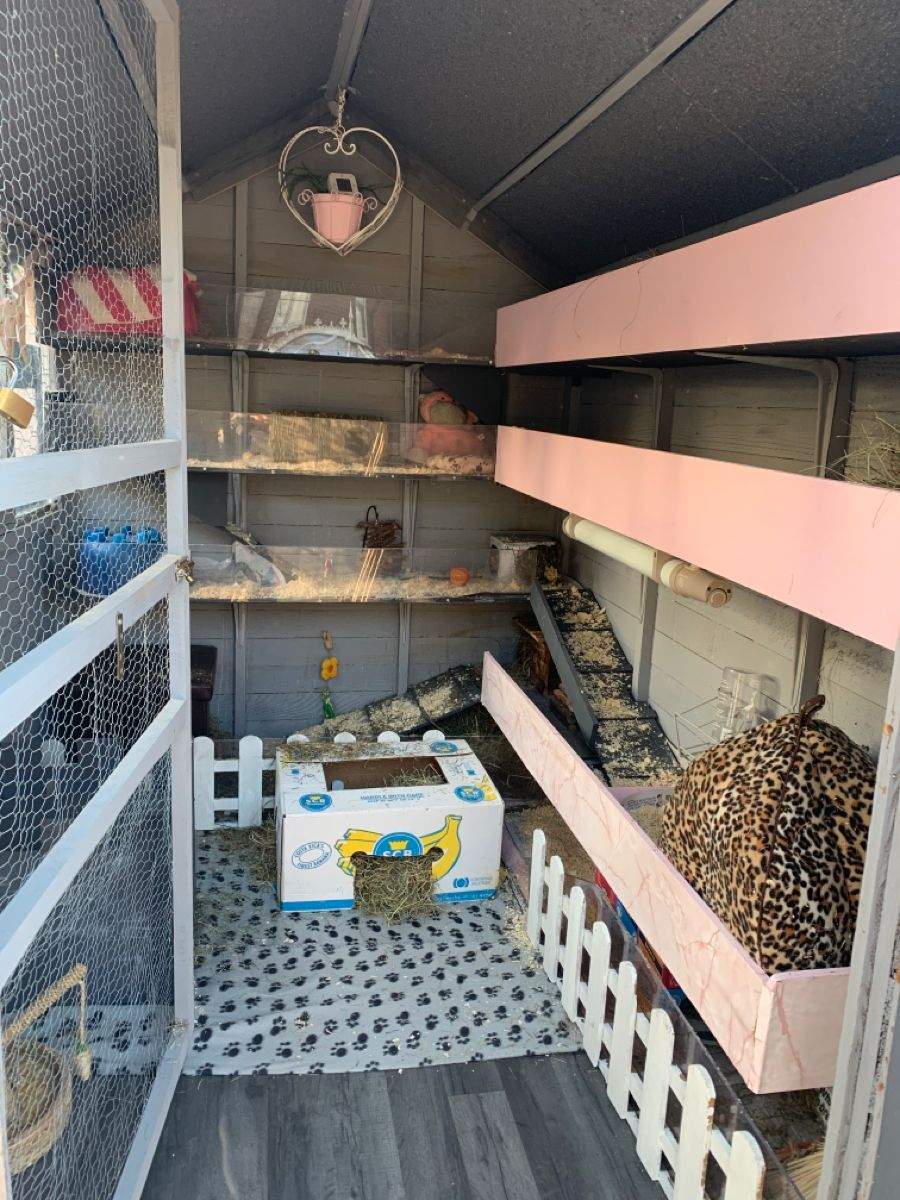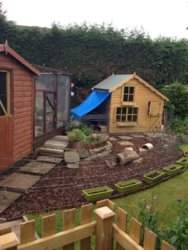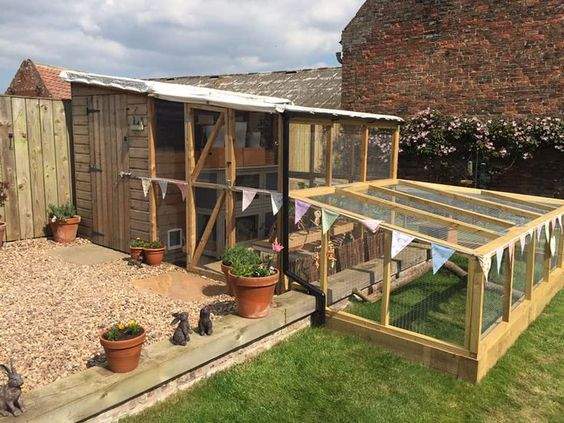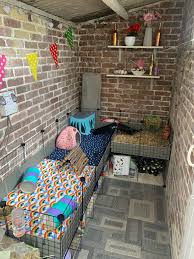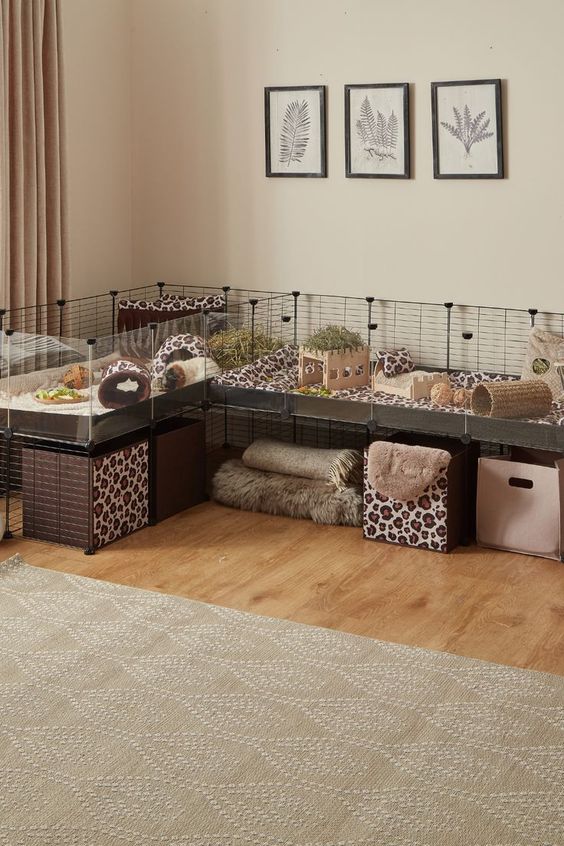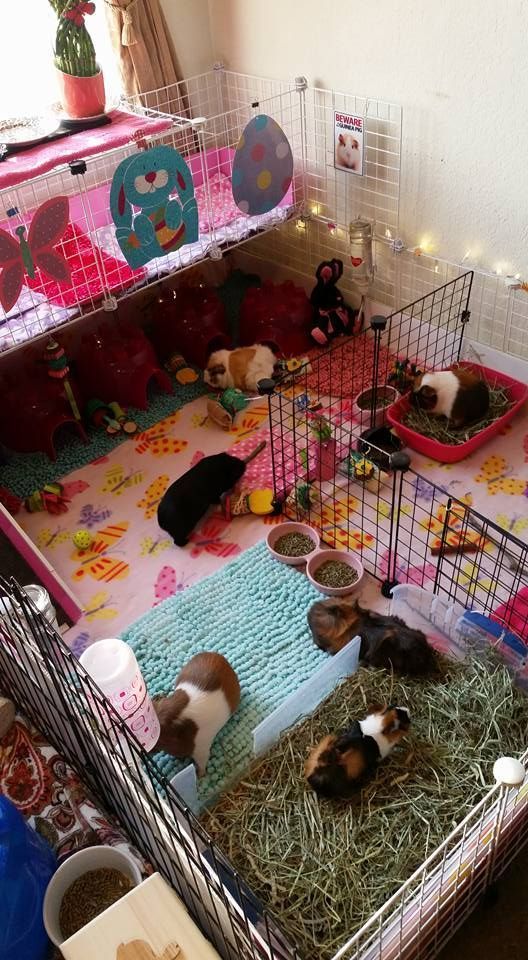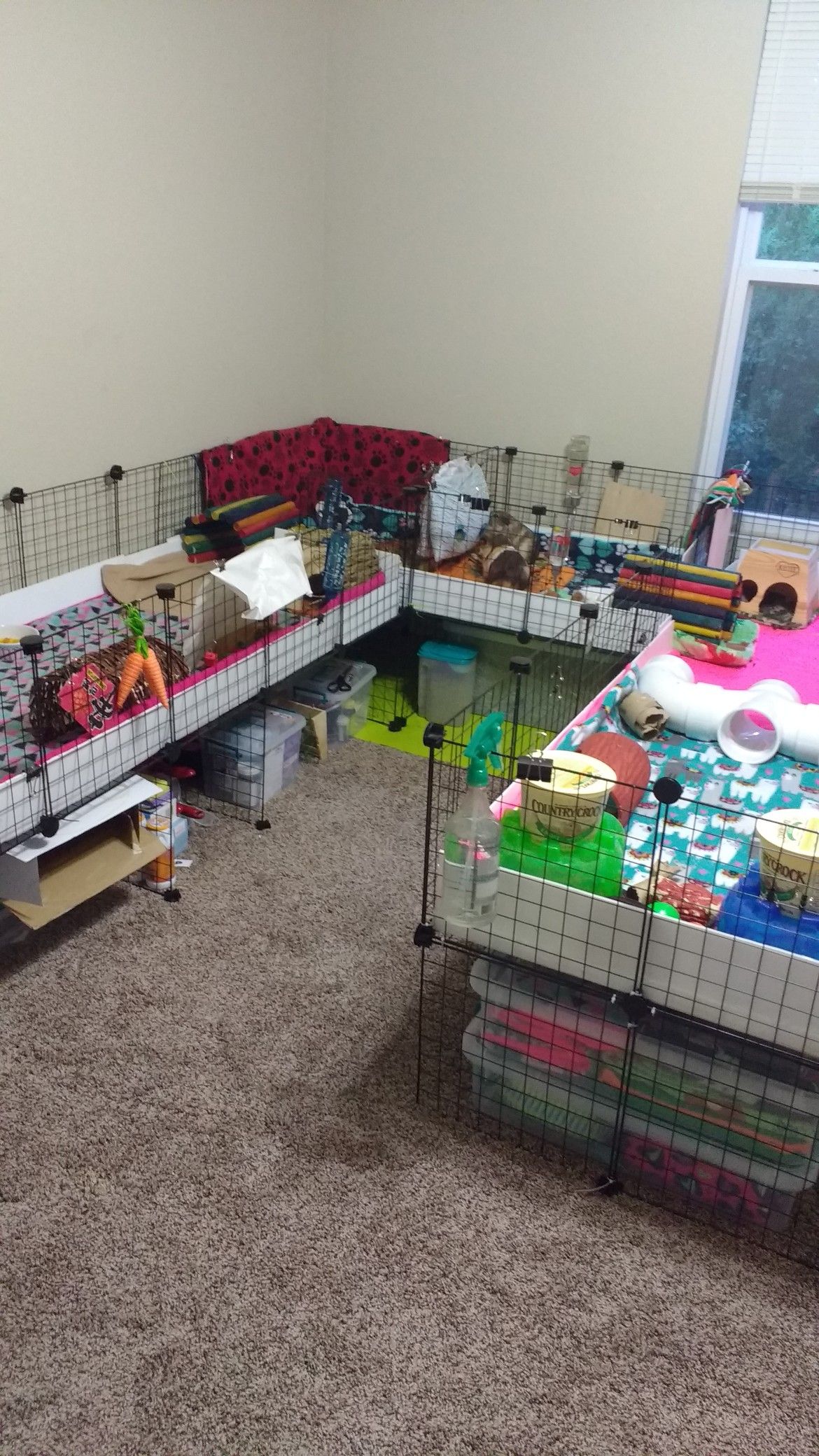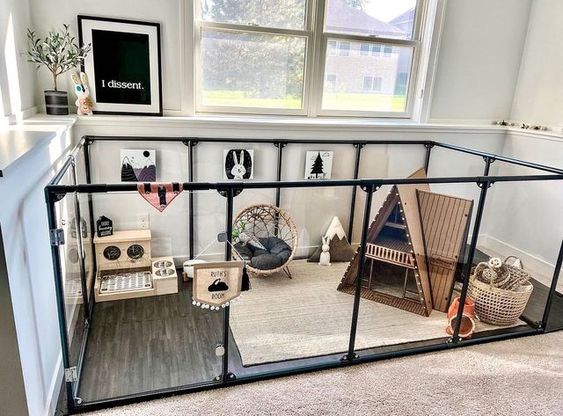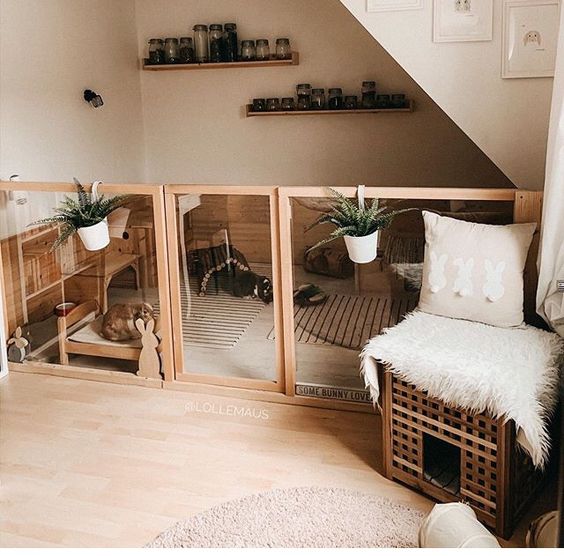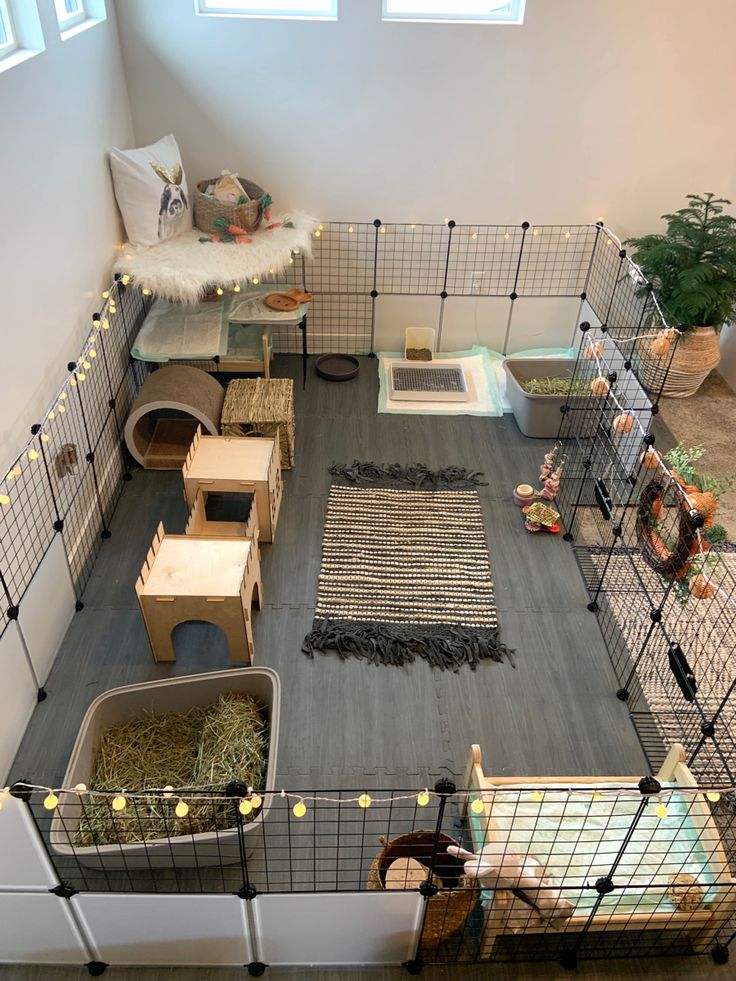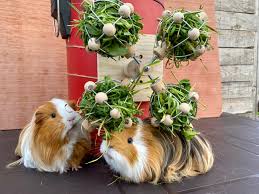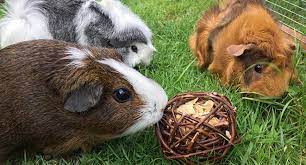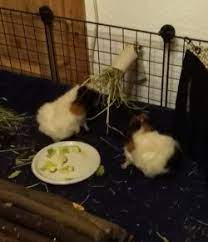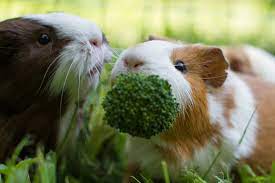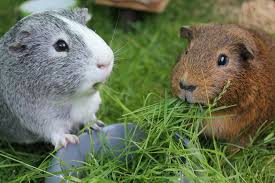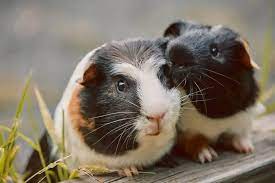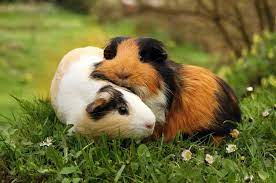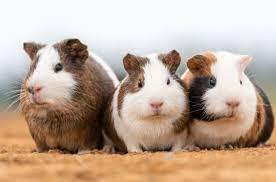GUINEA PIG CARE INFORMATION
If you have any questions relating to guinea pig care, please be advised that we are always here to help, whether or not you are adopting from an RSPCA Branch.
For any queries you may have about caring for guinea pigs, please email emily@rspcaworcester.org.uk .
(*Please note that we are NOT qualified to give out veterinary advice; for any concerns about your guinea pig's health you should always contact your vet as soon as possible.)
1. Minimum size requirements - A living space
Our minimum sized accommodation requirements for guinea pigs are:
2 Guinea pigs - 6ft x 2ft
3 Guinea pigs - 7ft x 2ft
4+ Guinea pigs - please email us at emily@rspcaworcester.org.uk
Runs for the grass outside - 6ft x 4ft
These are the very minimum recommendations, BIGGER is always BETTER.
Guinea pigs only sleep for a few hours each day spread out in 'naps' therefore they are awake just as much at night as during the day. Due to this, even just overnight, its important to give them the same amount as space as the daytime, therefore if you shut them in a smaller space at night, you are denying them the opportunity to express fundamental behaviours like :-
 Popcorning
Popcorning  Zoomies
Zoomies  Hiding
Hiding  Foraging/Grazing
Foraging/Grazing  Lying fully stretched out
Lying fully stretched out
2. Outdoor housing
It can be difficult to buy purpose-built accommodation measuring these dimensions but there’s no reason why you can’t build your own!
Guinea pigs are a prey species and need to be able to hide from things that scare them. They need to hide in secure places, away from sights and smells of predators (e.g. foxes/cats/dogs/ferrets/birds of prey). Making sure that your accommodation is escape-proof as well as fox-proof is essential!
Many people are now looking at alternative accommodation to hutches as they can be difficult to buy that meets the minimum size and build to ensure that animal welfare standards are met. Not only is size an issue but also weatherproofing. Most hutches found online or in pet shops are made out of thin and weak materials that do not stand the test of time or our cold, wet British weather.
Shelter and run :-
A hutch is NEVER enough! A run should always be permanently attached to the sleeping quarters/internal shelter with 24/7 access.
The minimum for internal shelters is 6ft x 2ft for a pair and this is the size of the enclosed area where weather cannot get in, most hutches found online unfortunately have most of the shelter exposed to the UK weather via wire mesh and therefore not suitable. Please note we do not rehome to hutches outside that are not placed in a larger area like an outbuilding/ shed etc.
Converted shed/Wendy house and run :-
Converting a shed, Wendy house or summerhouse into the perfect guinea pig paradise is getting more and more popular, as some people may already have one they can convert or they can be bought 2nd hand or even new for a similar price or even cheaper then hutches. Not only do sheds or Wendy houses offer more room for your furry friends but they are also easy to insulate for the colder weather and last much longer than a hutch; as well as giving the owners the option to go inside making it easier to clean and interact with the guinea pigs. Runs can be easily attached to the side of a shed with access via a hole or tunnel. For more information on how to covert a shed/wendyhouse please email us at emily@rspcaworcetser.org.uk
Below are some examples of ideal outdoor guinea pigs housing.
3. Indoor housing
Housing guinea pig's inside is becoming very popular, not only are you able spend more time socializing with your furry friends but it can also be cheaper housing, and protection from predictors and our bad British weather; but before rushing into it please consider the following;
 Where in your home are you going to keep them? - Will they get disturbed by loud appliances like TVs or will they be housed next to a draught?
Where in your home are you going to keep them? - Will they get disturbed by loud appliances like TVs or will they be housed next to a draught? Do you have enough room? - Indoor guinea pigs need the same amount of space as outdoor guinea pigs.
Do you have enough room? - Indoor guinea pigs need the same amount of space as outdoor guinea pigs. Will they still have access to an area outdoors? - It is important to give your rabbits access outside to fulfill natural behaviours and be able to graze on grass.
Will they still have access to an area outdoors? - It is important to give your rabbits access outside to fulfill natural behaviours and be able to graze on grass. Is your home 'guinea pig safe'? - Other pets, house plants and electric wires can all pose a risk to your guinea pig's safety.
Is your home 'guinea pig safe'? - Other pets, house plants and electric wires can all pose a risk to your guinea pig's safety.Indoor cages come in many different sizes, and whilst you can dedicate a whole spare room to guinea pigs, some people may not have that option, and that's where C&C caging is a great option. I have put some links below on options of C&C caging to buy; which can come with a fitted base for easy clean-up, or just the C&C panals which gives you more flexibility on the shaping your cage to fit a certain area or size you want.
The flooring of your cage should be easy to clean up, like lino or plastic, with a nonslip washable fleece bedding. Other bedding that is guinea pig safe is carefresh or other paper based bedding that can be found at most pet-shops. Sawdust/ wood shavings should be avoided as it can cause respiratory issues due to the dust.
Examples of C&C caging that can be bought :-
-
https://candcguineapigcages.co.uk/product/standard-2-x-6-grid-cage/
- https://kaveecage.co.uk/products/6x2-white-c-c-cage-guinea-pig
- https://www.amazon.co.uk/AmazonBasics-Cube-Wire-Storage-Shelves/dp/B0735GRJXY/ref=asc_df_B0735GRJXY/...
- 2x - https://www.amazon.co.uk/Langxun-Storage-Organizer-Products-Portable/dp/B078BC54SJ/ref=sr_1_6?adgrpi...
Examples of indoor bases and liners :-
- https://www.homebase.co.uk/antinox-temporary-protection-black-2mm/12812544.html
- https://www.amazon.co.uk/beueyfr-Washable-Absorbent-Waterproof-Shrinkage/dp/B0C7MS3QGR/ref=sr_1_2_ss...
https://www.amazon.co.uk/dp/B077R1NXWF?tag=track-ect-uk-792842-21&linkCode=osi&th=1&psc=...
4. Enrichment
Guinea pigs love to snuffle around and forage for food, and will spend most of their time doing this, so rather than using a bowl for their nuggets or fresh food, try hiding the food around the enclosure, in tunnels and other places to get their noses working. This will encourage them to forage for their food and prevent boredom and obesity. You can also try;
 Treat balls for them to push around to get the pellets or treats out.
Treat balls for them to push around to get the pellets or treats out. Toilet roll tubes, willow tunnels, egg boxes, paper bags or cardboard boxes stuffed with hay and fresh food for them to break their way into.
Toilet roll tubes, willow tunnels, egg boxes, paper bags or cardboard boxes stuffed with hay and fresh food for them to break their way into.  Stringing up willow, hazel, apple and blackthorn branches for them to reach up for.
Stringing up willow, hazel, apple and blackthorn branches for them to reach up for. Hiding treats or nuggets in snuffle-mats that you can either buy or make out of old, clean rags.
Hiding treats or nuggets in snuffle-mats that you can either buy or make out of old, clean rags. A quick search on Google, Pinterest and Youtube will bring up loads of enrichment ideas you can try with you guinea pigs.
Guinea pigs are prey animals and don't like open spaces or areas that they cant quickly dip under cover, so to ensure they feel safe in their home, make sure you provide lots of hiding places. You can provide cheap hiding places by using tunnels, stools and cardboard boxes.
Socialising :-
Guinea pigs are highly social animals and need to have the companionship in the form of another guinea pig; in the wild they live in groups of 8 plus individuals. No matter how much time we spend with them, nothing matches the company of another guinea pig. Not only does company prevent them from being lonely, it always makes them feel safer as there are more eyes looking out for danger.
 As stated above, guinea pigs are prey animals. As prey animals, they like to be able to check out their surroundings. Making sure your accommodation is secure from any predators is essential. Chicken wire unfortunately isn't secure enough for foxes, using welded mesh is preferred as its strong enough to withstand any nosy and dangerous neighboring animals.
As stated above, guinea pigs are prey animals. As prey animals, they like to be able to check out their surroundings. Making sure your accommodation is secure from any predators is essential. Chicken wire unfortunately isn't secure enough for foxes, using welded mesh is preferred as its strong enough to withstand any nosy and dangerous neighboring animals.  Try not to give them every toy all in one go. Switch toys and furniture around every now and again so they don’t get bored.
Try not to give them every toy all in one go. Switch toys and furniture around every now and again so they don’t get bored.5. Diet
Nuggets :-
5% of of their diet should made up of good quality nuggets (like Excel or Science select), only giving them about 20g a day. Each nugget or pellet contains the same nutrients and helps provide a balanced diet.
Vitamins :-
Guinea pigs diet also needs added vitamin C as they cannot produce this themselves and need to have it supplemented into their diet. Vitamin C can be found in good quality, high fibre nuggets and some fresh greens.
Fresh greens :-
When feeding your animals any new foods, please check the list or research online to see if it is safe to feed your furry friends. All plants and vegetables should be washed before being given. The best food you can give is leafy greens like kale, some spinach, cavolo Nero and also some herbs like mint, basil and coriander! The occasional vegetable like broccoli adds a bit of vitamin C which is very important from their health. You don't have to always buy food from the supermarket, try growing some plants in your garden or have a forage around as well!
They must have access to plenty of fresh water at all times. You can provide water either from a water bottle and / or a water bowl. Water bowls are a more natural way for them to drink but they can get spilled easily so providing both is recommended. Please ensure you refresh their water daily and, if using water bottles, you give them a good clean at least once a week with a bottle brush to ensure algae doesn't grow.
7. Holiday Care
Choosing to keep your guinea pigs in their home and getting someone to stay with them or to pop in a couple times a day is the preferred option for many owners as it is less stressful for them to stay in their own, familiar environment. Most people will get a family member, friend or neighbour to care for their pets when away but please be sure they are savvy and know what to look out for if your piggies are to suddenly become unwell. If you are not able to get someone you know to look after your furry friends, then a professional pet sitter is the next best thing.
If you cannot keep your guinea pigs in your home when you are away, then you can choose to board them instead. There are many professional boarding establishments, however finding a good one can be tricky. Before dropping them off to a boarder, make sure you check out reviews online, ask your local vets and check out the place before making any arrangements. All good boarding places should stick to the minimum size requirements, have clean accommodation and have plenty of time to monitor and spend time with your furry friends. When you find a place, make sure to bring your guinea pigs' enrichment and some used, but clean, bedding so they have something familiar in a their new, temporary environment.
8. Transporting your guinea pigs
 Before travelling, always consider
whether the planned journey is
necessary and in the their best
interests. If it is not, reconsider
undertaking the journey, as
transportation is potentially stressful.
Before travelling, always consider
whether the planned journey is
necessary and in the their best
interests. If it is not, reconsider
undertaking the journey, as
transportation is potentially stressful. Try to ensure that anywhere you need to transport your guinea pigs to (such as a
veterinary practice) is located close to your home, to ensure they do not
have to travel long distances.
Try to ensure that anywhere you need to transport your guinea pigs to (such as a
veterinary practice) is located close to your home, to ensure they do not
have to travel long distances. Make sure your guinea pigs are fit to travel and if in any doubt, contact your vet.
Make sure your guinea pigs are fit to travel and if in any doubt, contact your vet. Guinea pigs do not tolerate heat well, so ensure your vehicle is kept cool and well
ventilated, and avoid travelling during the hottest parts of the day.
Guinea pigs do not tolerate heat well, so ensure your vehicle is kept cool and well
ventilated, and avoid travelling during the hottest parts of the day. Remember that guinea pigs are prey animals and are easily frightened, so ensure they
have access to safe hiding places at all times.
Check on them regularly, and give them frequent breaks, during long journeys.
Remember that guinea pigs are prey animals and are easily frightened, so ensure they
have access to safe hiding places at all times.
Check on them regularly, and give them frequent breaks, during long journeys. Provide constant access to fresh clean water. Portable, non-spill watering aides can
be purchased. Always provide them with water in the way they are familiar
with (e.g. bottle or bowl) and check their water supply regularly.
Provide constant access to fresh clean water. Portable, non-spill watering aides can
be purchased. Always provide them with water in the way they are familiar
with (e.g. bottle or bowl) and check their water supply regularly. Please make sure there is hay available for your guinea pigs to eat in the carrier. It is important to ensure that they are continuing to eat normally after he/she has been on a journey. If your
guinea pig's eating or drinking habits changes or the number of droppings gets less or
stops, talk to your vet straight away as he/she could be ill.
Please make sure there is hay available for your guinea pigs to eat in the carrier. It is important to ensure that they are continuing to eat normally after he/she has been on a journey. If your
guinea pig's eating or drinking habits changes or the number of droppings gets less or
stops, talk to your vet straight away as he/she could be ill. Never starve your guinea pig before taking them to the vets. Unlike cats and dogs
going to the vets for an operation, they do not need to be starved before going to
the vets, as their digestive system needs to be kept moving at all times.
Never starve your guinea pig before taking them to the vets. Unlike cats and dogs
going to the vets for an operation, they do not need to be starved before going to
the vets, as their digestive system needs to be kept moving at all times. Transport your pets in a sturdy, non-collapsible, well ventilated and secure carrier
that they cannot chew easily or escape from (cardboard boxes are not
appropriate as they are easily chewed and can become damp and unsafe if they urinate or if it rains).
Transport your pets in a sturdy, non-collapsible, well ventilated and secure carrier
that they cannot chew easily or escape from (cardboard boxes are not
appropriate as they are easily chewed and can become damp and unsafe if they urinate or if it rains). Ensure your carrier is of a suitable size and shape to allow all your guinea pig to be transported easily, lie comfortably in any direction and turn around
unhindered.
Ensure your carrier is of a suitable size and shape to allow all your guinea pig to be transported easily, lie comfortably in any direction and turn around
unhindered.  Choose a carrier of a design that opens from the top and the front to allow them to be removed easily.
Choose a carrier of a design that opens from the top and the front to allow them to be removed easily.  Line the carrier with newspaper to absorb urine and a towel or vet bed to provide a
non-slip surface.
Line the carrier with newspaper to absorb urine and a towel or vet bed to provide a
non-slip surface. Partially cover the carrier to help your piggies feel more secure, especially when
travelling at night to prevent them being frightened by the glare of car headlights. If the carrier is partially covered, ensure there is adequate ventilation.
Partially cover the carrier to help your piggies feel more secure, especially when
travelling at night to prevent them being frightened by the glare of car headlights. If the carrier is partially covered, ensure there is adequate ventilation.  Familiarise your pets with the carrier
beforehand by leaving it open in their home
enclosure, with the front door open to encourage
them to investigate.
Familiarise your pets with the carrier
beforehand by leaving it open in their home
enclosure, with the front door open to encourage
them to investigate. Strap the carrier into your vehicle with a seat belt or secure it in a footwell (behind a
seat), so the carrier cannot shift around or be jolted on the journey.
Strap the carrier into your vehicle with a seat belt or secure it in a footwell (behind a
seat), so the carrier cannot shift around or be jolted on the journey. Never place the carrier in direct sunlight or in the boot of a saloon car.
Never place the carrier in direct sunlight or in the boot of a saloon car. Remember that guinea pigs that live together and are friends should travel together. This provides the reassurance of safety in
numbers and also ensures that the same
scents are transferred to both while
out and about, which avoids the potential
problems associated with reintroducing after a period of time apart. If you do
experience problems when reintroducing at any time, speak to your vet
for advice. Your vet can then refer you to a
qualified behaviour expert if necessary.
Remember that guinea pigs that live together and are friends should travel together. This provides the reassurance of safety in
numbers and also ensures that the same
scents are transferred to both while
out and about, which avoids the potential
problems associated with reintroducing after a period of time apart. If you do
experience problems when reintroducing at any time, speak to your vet
for advice. Your vet can then refer you to a
qualified behaviour expert if necessary.  Place familiar items in the carrier, such as their favourite toys and
some used bedding material (like hay), to provide familiar smells and reassurance.
Place familiar items in the carrier, such as their favourite toys and
some used bedding material (like hay), to provide familiar smells and reassurance.
9. Advice on successfully bonding guinea pigs
Guinea pigs are sociable animals and we always advise that they need to be homed with other guinea pigs. As a first-time guinea pig owner, we would always recommend that you should adopt two already bonded piggies. If you have found yourself with a single piggy then please take a look at our bonding tips below. All male guinea pigs in a home must be neutered before adoption of any guinea pigs from us.
Preparation is key!
First you should find the right friend for your guinea pig. A male / female pairing (or single male to a group of females with the male neutered of course) tends to work best.
You must ensure that both in good health and that a number of weeks (6-8 is recommended) has passed after neutering any male pigs. Not only can unneutered male and female able to mate, but neutered guinea pigs are less likely to fight.
Give your pigs lots of space! Remember you are suddenly asking your guinea pigs to share their space with a stranger so they need plenty of personal space and places to hide. Make sure you provide extra toys and tunnels as you don’t want your pets feeling that they have to fight for resources.
Recommended bonding techniques:-
Remember you must always keep a close eye on both or all pigs during the bonding process in case any fights break out or ill health occurs.
 Put the guinea pigs in enclosures next to one another so they can see, smell and hear each other.
Put the guinea pigs in enclosures next to one another so they can see, smell and hear each other.  Place hay trays, food, and their favourite snacks next to each other on both sides of the divider so they become used to eating in each other’s company. As they get more used to one another you can feed them closer and closer to one another.
Place hay trays, food, and their favourite snacks next to each other on both sides of the divider so they become used to eating in each other’s company. As they get more used to one another you can feed them closer and closer to one another. Try swapping toys and bedding so they can get used to each other’s smell.
Try swapping toys and bedding so they can get used to each other’s smell. Take things slowly and look for signs that your they are relaxed. It is a good sign if both guinea pigs are choosing to sit beside one another through the barrier, and a great sign if they are lying down in a relaxed position.
Take things slowly and look for signs that your they are relaxed. It is a good sign if both guinea pigs are choosing to sit beside one another through the barrier, and a great sign if they are lying down in a relaxed position. Once you feel confident that they are ready to meet face-to-face you should ensure their first meeting occurs in neutral territory – ie: a space that neither one of them has been before to ensure neither becomes protective of what they deem as “their” space. Provide lots of hiding places/tunnels (open at both ends so neither can end up trapped by the other) and scatter hay and treats around.
Once you feel confident that they are ready to meet face-to-face you should ensure their first meeting occurs in neutral territory – ie: a space that neither one of them has been before to ensure neither becomes protective of what they deem as “their” space. Provide lots of hiding places/tunnels (open at both ends so neither can end up trapped by the other) and scatter hay and treats around. When you let them loose together put them at opposite ends of the area, so they have the choice whether they want to meet their new companion straight away or take time and space to weigh up the situation. You must always stay with them, keeping a close eye on them and their behaviour.
When you let them loose together put them at opposite ends of the area, so they have the choice whether they want to meet their new companion straight away or take time and space to weigh up the situation. You must always stay with them, keeping a close eye on them and their behaviour. They may chase one another, this is normal behaviour but keep a close watch to ensure there are no signs of aggression or stress.
They may chase one another, this is normal behaviour but keep a close watch to ensure there are no signs of aggression or stress. To begin with, keep the ‘meetings’ short, one minute is a good starting time. You may have to build up the meetings over several days or even weeks, following the above processes and moving back a step and repeating if there are any negative signs.
To begin with, keep the ‘meetings’ short, one minute is a good starting time. You may have to build up the meetings over several days or even weeks, following the above processes and moving back a step and repeating if there are any negative signs.Good signs to look out for when bonding are:-
 Sitting or lying side-by-side
Sitting or lying side-by-side Grooming one another (when they are in their neutral territory)
Grooming one another (when they are in their neutral territory) Seeking each other out for positive interactions
Seeking each other out for positive interactions Behaving normally around one another
Behaving normally around one anotherOnce they are showing signs of being friends you can move on to putting them together in the home they will share. Again, you must keep a close watch over them and although you may see more chasing behaviour, this should not escalate into fighting-if it does, separate them immediately and go back a step in the process. Like with the mutual space, take it slowly, and only have them in their home together for a brief time to begin with, slowly increasing it as you go.
Once they are happily lying together and grooming one another you can consider your piggies successfully bonded. Once they are bonded, they MUST stay together at all times; even if one has to go the vet then their pal should go with them.
Here's also a great page by the PDSA with lots of types on bonding guinea pigs - https://www.pdsa.org.uk/pet-help-and-advice/looking-after-your-pet/small-pets/introducing-guinea-pig...
The above process can take a long time but don’t be tempted by suggested techniques to bond quickly or using fear or stress to bond. You may have read online about “speed dating” which is made to sound cute and fun but introducing without a period of prior familiarisation can be extremely problematic.
Guinea pigs are sensitive animals, prone to stress which can quickly make them ill. Being transported to a strange place, being placed into an alien environment and being given no time to adjust is extremely stressful. This can lead to aggression, risking injury and, even if they do appear to be getting along, you aren’t getting a true picture of whether they are compatible -what you are seeing is tolerance as a means of trying to handle their stress.
There are also techniques which use fear to force guinea pigs into bonding as self-preservation. This is known as “stress bonding” and it involves putting them into a small confined space where they cannot escape one another and exposing them to a frightening experience such a taking them on a rough car journey, running a vacuum cleaner next to them or placing the carrier on top of a spinning washing machine.
These techniques are incredibly harmful and do not encourage true friendship between pigs, rather it creates a learned helplessness where they become shut-down through fear. Also guinea pigs that have been put through stressful bonding techniques in the past are far more likely to struggle to bond with other animals in the future.
Avoid anyone who claims they can wave a magic wand and guarantee your piggies can be bonded within a specific and short timescale (often people will say ‘within two weeks’). Bonding done properly can take a great deal of time and patience, but the rewards at the end are happy, healthy pets who enjoy the company of their friends.
10. Checklist
Daily:
 Check and change soiled areas
Check and change soiled areas
 Refresh water bottle/bowl
Refresh water bottle/bowl
 Refresh hay
Refresh hay
 Check bottoms, and in the summer/ warmer months this should be twice daily
Check bottoms, and in the summer/ warmer months this should be twice daily
 Feed 10% fresh and 5% nuggets
Feed 10% fresh and 5% nuggets
Weekly:
 Completely clean accommodation
Completely clean accommodation Do a health check especially looking for:
Do a health check especially looking for:Eyes - Make sure they are clear and bright - Ears - Clean with no foreign bodies - Teeth - Make sure they are eating and drinking ok, being given lots of opportunities to chew and not dribbling - Fur - Not balding, making sure there are no parasites and that their fur is mat-free and shiny - Skin - No lumps, bumps or injuries - Bottom - Clean bum with no soiling/ faeces stuck to their fur - Nails - Look at the length, checking to see if they need trimming
